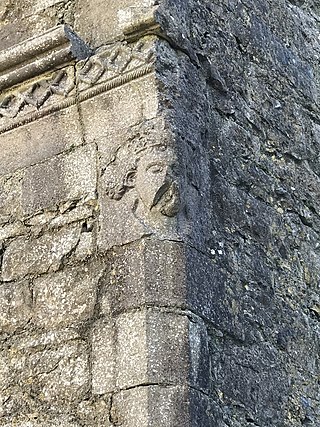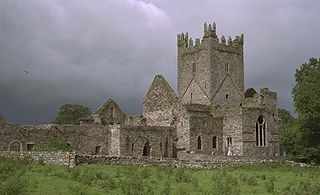
Connacht or Connaught, is one of the four provinces of Ireland, in the west of Ireland. Until the ninth century it consisted of several independent major Gaelic kingdoms.

Ruaidrí mac Tairrdelbach Ua Conchobair was King of Connacht from 1156 to 1186, and High King of Ireland from 1166 to 1198. He was the last High King of Ireland before the Anglo-Norman invasion.

William de Burgh was the founder of the House of Burgh in Ireland and elder brother of Hubert de Burgh, 1st Earl of Kent and Geoffrey de Burgh, Bishop of Ely. William is often given the epithet, "the conqueror", but is not to be confused with the English king of the same nickname.

West Connacht was a kingdom of Gaelic Ireland, associated geographically with present-day County Galway, particularly the area known more commonly today as Connemara. The kingdom represented the core homeland of the Connachta's Uí Briúin Seóla kindred and although they ruled, there were smaller groups of other Gaels in the area, such as the Delbhna Tir Dha Locha and the Conmhaícne Mara. It existed from 1051 onwards, after the Ó Conchobhair, Kings of Connacht, pushed the Ó Flaithbheartaigh to the West of Lough Corrib, from their original territory of Maigh Seóla. Iar Connacht remained a subordinate túath of Connacht, until the 13th century, after which it was more independent.

Cathal Crobhdearg Ua Conchobair (1153–1224), was a king of Connacht. He was the youngest son of the High King of Ireland Tairrdelbach Ua Conchobair and brother to the last fully recognized High King Ruadri Ua Conchobair. His own sons Aedh Ua Conchobair and Feidhlimidh Ua Conchobair were kings of Connacht after him.

Felim O'Connor was king of Connacht in Ireland, having been proclaimed king by Richard Mór de Burgh in 1230, he reigned proper from 1233 until 1265. Felim died in that year and was buried in the Dominican Priory in Roscommon which he founded in 1253. On his accession Felim inherited many problems from his predecessors, having his territory limited to essentially County Roscommon and having to deal with an increase of English and Welsh settlers in the kingdom. Felim attempted to maintain both a loyal and personal relationship with Henry III King of England, hoping he would limit the influence of de Burgh and other powerful Anglo-Norman magnates in Connacht, but this policy of appeasement produced few concrete results. During Felim's reign the lands of the Ua Conchobair became limited to the five 'royal cantreds', essentially County Roscommon. Felim notably adopted aspects of Anglo-Norman culture as seen in his English style effigy and seal.
Áed mac Felidlimid Ó Conchobair, known as Áed na nGall, was king of Connacht alongside his father Felim from 1258 reigning solely from 1265 until his own death in 1274. He is credited with turning the tide on Norman expansion in Connacht at the Battle of Áth an Chip. Aed took a different approach than his father to dealing with English crown authority in Ireland, placing his faith in alliances with the Gaelic speaking world and becoming the chief supporter of Brian Ua Neill's bid to revive the high kingship of Ireland. His byname na nGall comes from his marriage in 1259 to a daughter of Dubhghall mac Ruaidri King of the Hebrides which brought him 160 gallowglass commanded by Dubhghall's younger brother Ailéan as a dowry.
Brian Luighneach Ua Conchobhair was a prince of Connacht.

Jerpoint Abbey is a ruined Cistercian abbey, founded in the second half of the 12th century in County Kilkenny, Ireland. It is located 2.5 km south west of Thomastown on the R448 regional road. There is a visitor centre with an exhibition. It has been declared a national monument and has been in the care of the Office of Public Works since 1880.

Corcomroe Abbey is an early 13th-century Cistercian monastery located in the north of the Burren region of County Clare, Ireland, a few miles east of the village of Ballyvaughan in the Barony of Burren. It was once known as "St. Mary of the Fertile Rock", a reference to the Burren's fertile soil.
Events from the year 1224 in Ireland.
Cathal is a common given name in Ireland, spelled the same in both the Irish and English languages. The name is derived from two Celtic elements: the first, cath, means "battle"; the second element, fal, means "rule". There is no feminine form of Cathal. The Gaelic name has several anglicised forms, such as Cathel, Cahal, Cahill and Kathel. It has also been anglicised as Charles, although this name is of an entirely different origin as it is derived from a Germanic element, karl, meaning "free man".

Knockmoy Abbey, also known as The Monastery of the Hill of Victory ; and as Porta Magna and Teampollandorusmoir after the dissolution of the monasteries, is a ruined Cistercian abbey located in Abbeyknockmoy, County Galway, Ireland. Founded in 1198, the abbey is known for its wall-paintings.
The Clan Murtagh O'Conor were descendants of Irish High-King Toirdelbach Ua Conchobair, through his son, Murtogh Moynagh O'Conor (d.1210), tánaiste of Connacht. They have been defined by Katherine Simms as:
... the earliest, most aristocratic and best documented example of increasing nomadism in the northern half of Ireland in the late middle ages. ... In spite of the fact that they were a very numerous branch of the O'Conor family, who supplied five kings to the throne of Connacht, they seem to have vanished away in the early fifteenth century, never to be heard of again.
Fearghal Ó Taidg an Teaghlaigh, Chief of the Name, Marshal and bodyguard of King Cathal Crobhdearg Ua Conchobair of Connacht and his successor, Aedh, died 1226.
Lasairfhíona, is an Irish language feminine given name. The name means "wine flame" or "flame of wine" as it derives from the Irish words lasair meaning "flame" and fhíona, the lenited genitive form of fíon meaning "wine". The "fh" combination is silent in Irish and spelling variations of this name also include Lasairíona.
The Uí Fiachrach were a royal dynasty who originated in, and whose descendants later ruled, the coicead or fifth of Connacht at different times from the mid-first millennium onwards. They claimed descent from Fiachrae, an older half-brother of Niall Noigiallach or Niall of the Nine Hostages. Fiachrae and his two full brothers, Brion and Ailill, were the collective ancestors of the Connachta dynasty that eventually became the new name of the province. Their mother was Mongfind.
Events from the year 1216 in Ireland.
Events from the year 1190 in Ireland.










